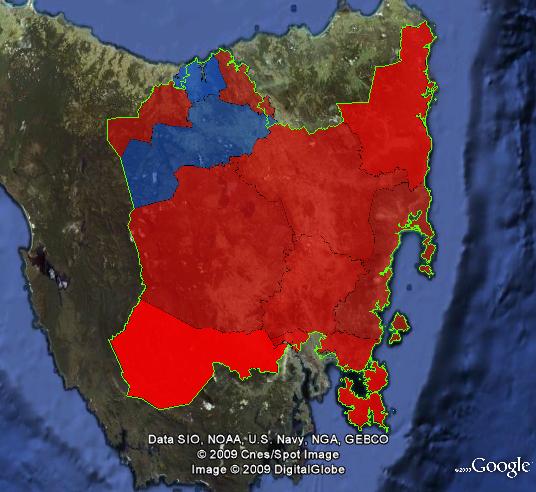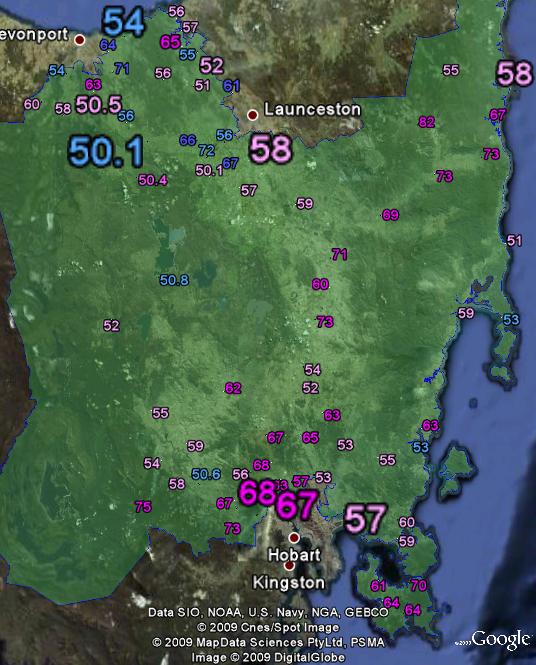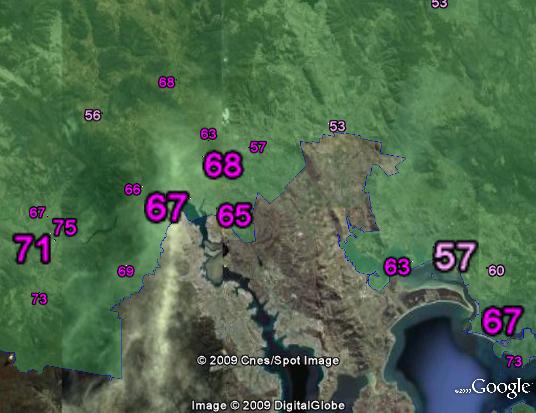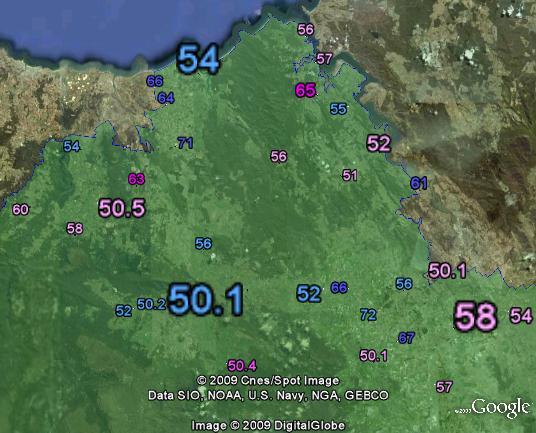ALP 8.3%
Incumbent MP
Dick Adams since 1993.
Geography
Tasmania’s largest seat by area, Lyons includes parts of every region of the state. The seat stretches from the outskirts of Devonport and Launceston in the north to the outskirts of Hobart in the south, as well as the central highlands and the east coast of Tasmania.
Redistribution
The redistribution saw changes at both ends of the seat. Lyons lost the west coast of Tasmania, a geographically large area with a relatively small population, to Braddon. In exchange it gained part of Latrobe LGA, including Port Sorell. At the southern fringe of the seat, the remaining territory in Derwent Valley LGA was gained from Franklin. Lyons also gained more of Brighton LGA from Franklin, while it lost the remainder of Clarence LGA to Franklin.
Demographics
Lyons has a very low proportion of the population born overseas (9% compared to 21.9% nationally) or born in a non-english-speaking country (1.8% compared to 10% nationally). In terms of employment, the electorate has a very low proportion working in professional or financial areas, while 11.5% work in agriculture, fisheries and forestry, compared to 3.1% nationally.
History
Lyons was originally named Wilmot, which was created as a central Tasmanian electorate in 1903. The seat was held by a variety of non-Labor parties up to 1929, when the seat was won by former Premier of Tasmania Joseph Lyons. He left the ALP during his first term in federal Parliament and was elected Prime Minister in 1931 at the head of the new United Australia Party. The ALP won the seat in a 1939 by-election following Lyons’ death, but lost the seat at the 1940 election. The ALP’s Gil Duthie won the seat at the 1946 election, and held the seat until the 1975 election, when he was defeated by the Liberal Party’s Max Burr.
In 1984, the seat was renamed Lyons in honour of the former Prime Minister and his wife Enid, who was the first female member of the House of Representatives. Burr held the renamed seat until 1993, when he retired and the ALP’s Dick Adams won the seat. Adams has held the seat ever since. At the 2004 election, a 4.5% swing against the ALP made the seat marginal, but in 2007 Adams recovered most of his margin, partly due to conflict in the Liberal Party, with the original Liberal candidate, Ben Quin, resigning and running as an independent after Minister for the Environment Malcolm Turnbull approved the Gunns pulp mill.
Candidates
- Lucas Noyes (Secular Party)
- Eric Hutchinson (Liberal)
- Dick Adams (Labor) – Member for Lyons since 1993.
- Karen Cassidy (Greens)
Political situation
The Gunns pulp mill on the Tamar Valley, while lying in the seat of Bass, is close to Lyons, particularly the tenth of the electorate which lies in West Tamar LGA.
2007 result
| Candidate | Party | Votes | % | Swing |
| Dick Adams | ALP | 27,734 | 43.15 | -1.41 |
| Geoff Page | LIB | 20,643 | 32.54 | -9.79 |
| Karen Cassidy | GRN | 7,089 | 11.17 | +1.22 |
| Ben Quin | IND | 6,092 | 9.60 | +9.60 |
| Amy Parsons | FF | 1,427 | 2.25 | -0.40 |
| Ray Williams | CEC | 819 | 1.29 | +0.78 |
2007 two-candidate-preferred result
| Candidate | Party | Votes | % | Swing |
| Dick Adams | ALP | 37,292 | 58.78 | +5.10 |
| Geoff Page | LIB | 26,152 | 41.22 | -5.10 |
These results do not take into consideration the effects of the redistribution.
Booth breakdown
Thirteen local government areas (LGAs) cover Lyons. Nine of these LGAs are entirely contained within Lyons, while the vast majority of Brighton, West Tamar and Meander Valley LGAs and about half of Latrobe LGA are contained in the division. The ALP won a majority of the two-party-preferred vote in eleven LGAs, while the Liberal Party won in Meander Valley and Latrobe LGA (which was part of Braddon in 2007). The ALP polled most strongly in the southern LGAs, particularly in Derwent Valley LGA, the Tasman peninsula and the northern Hobart suburbs of Brighton LGA. The ALP also polled well in Break O’Day LGA, in the northeastern corner of the seat. This can be seen in this map, which shows the two-party-preferred vote in each LGA.

In order to provide more meaningful analysis, it makes sense to divide the electorate into larger divisions. I grouped the thirteen LGAs into three areas which each make up about a third of the electorate. South covers Derwent Valley, Brighton, Sorell and Tasman LGAs, around the fringes of Hobart and the south of the electorate. Centre covers the central highlands, the midlands and the east coast. North-West covers the LGAs closest to the northern towns of Launceston and Devonport, including the two Liberal-voting LGAs of Meander Valley and Latrobe.
Using this analys, you find that the Liberals won a slight majority amongst voters in the North, while Labor won with 59% in the central region and over 65% in the South. The Greens did best in northern LGAs, particularly West Tamar LGA. Figures in North and South regions include estimates on the impact of the redistribution.
| Voter group | GRN % | ALP 2CP % | Total votes | % of ordinary votes |
| South | 9.72 | 65.74 | 20,338 | 36.21 |
| North | 11.59 | 50.24 | 18,287 | 32.56 |
| Central | 9.26 | 59.11 | 17,540 | 31.23 |
| Other votes | 14.76 | 58.35 | 10,164 |





Very picky, but the ‘island of Tasman’ – there is a small man-made canal separating it from the mainland, but really it’s a peninsula, not an island – it’s called the ‘Tasman Peninsula’.
Confirmed that Dick Adams is running again, and Eric Hutchinson is the Liberal candidate.
I can’t think of the big tasmanian without remembering this Costello moment in parliament
“Very picky, but the ‘island of Tasman’ – there is a small man-made canal separating it from the mainland, but really it’s a peninsula, not an island – it’s called the ‘Tasman Peninsula’.”
We can get even pickier than that! The man-made canal separates the Forestier Peninsula from the mainland, and then the Tasman Peninsula is joined to the Forestier by a narrow sandspit at Eaglehawk Neck. While the two combined form the Tasman LGA, the strictly correct name for the land over the canal is “Tasman and Forestier Peninsulas”.
That said, there weren’t any booths actually on the Forestier Peninsula in 2007, and the one just over the canal (Dunalley) wasn’t hugely pro-Labor, so saying the ALP polled most strongly on “the Tasman peninsula” as opposed to “the Tasman and Forestier Peninsulas” is certainly correct by location of vote, and most likely by origin as well. 🙂
Yes thanks Kevin, I actually did know that the Tasman Peninsula was actually only the part below Eaglehawk Neck, but I didn’t know the name of the other part.
The Greens candidate is Karen Cassidy.
My prediction: 1-2% swing to Libs.